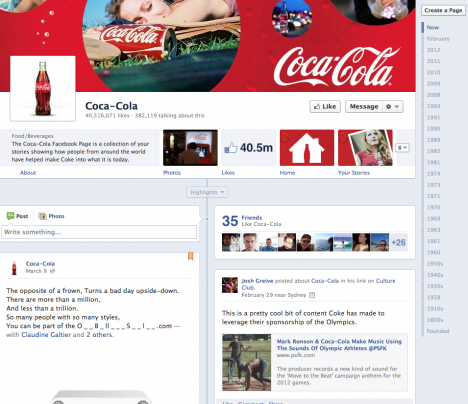Facebook’s Timeline for brands: finally a cure for the ‘ghost towns of the internet’:
 In this guest post, Daniel Monheit argues that Facebook’s new Timeline for brands will save the internet from abandoned brochureware websites.
In this guest post, Daniel Monheit argues that Facebook’s new Timeline for brands will save the internet from abandoned brochureware websites.
Ghost towns of the internet? Yup. We’ve all seen them. Truth be told, many of us have even played an active roll in creating them. They’re the traditional brochure site that’s become part of any brands’ ‘non negotiables’ over the last ten years. The five pager with ‘home’, ‘about’, ‘product range’, ‘news’, ‘contact’ and if you’re really lucky, ‘view our old TV commercials’. I know it sounds archaic, but in 2012 they’re still a reality, and have become a brand staple just like a name, a logo and a URL.
On the day they launch, both brand team and agency are proud as punch – but it seldom lasts. ‘Build website’ gets crossed off the to do list. New projects take attention and priority. The stats stop getting reviewed. Products don’t get updated. ‘News’ becomes embarrassingly old. Rust sets in, and before you know it, the site’s abandoned. Nobody visits. Nobody cares.
Cue tumbleweed.
On 29 February, Facebook announced that it was rolling out a string of new features, including ‘timeline’ for brands. The keynote presentation made only subtle references to timeline doing ‘everything a website could do’, but dumping one for the other makes sense for plenty of brands. Facebook is forcing all brands with a Facebook profile to adopt Timeline by the end of March.
Of course, the timeline roll out has brought the usual bitching and moaning that happens anytime someone rearranges our toys. But the overwhelming sentiment around it has been positive – and for good reason.
1. It’s really easy (and comparatively cheap) to set up
Taking a leaf from apple’s book, Facebook have found a nice balance between flexibility and control. They’re well placed to make many of the important decisions on our behalf and have done exactly that. They’ve settled on a format, outlined best practices, implemented rules to keep everything friendly, and cleared the hosting, technology, screen size and mobile compatibility hurdles that so many brands stumble upon. They’re also far more likely to maintain ‘best practice’ standards than most (read: free upgrades!).
At the same time, Facebook have left plenty of room for brands to really own their timelines with high impact visuals, native features like pinning and support for custom apps if they’re that way inclined. This means that brands can get started on their ‘online brochures’ without the raft of specialised skills that have typically been purchased from website companies. Facebook have already engaged the best UX, UI, programming and infrastructure guys going around. Brands just get to add the fun bits on top.
2. Party where the people are
Part of the reason brand sites become ghost towns is that it’s just so damn hard to get people to visit them. Sure, you can paste your URL on the back of packs, in your email signature or as the last quarter second of your TVC, but we’re really asking a lot of people – especially if your content is no good (more on this shortly). Launching a standalone brand site in 2012 is like ignoring the beach party with half a billion attendees in favour of setting up shop on a deserted island. Sure, there’s plenty of space and you can walk around naked but man it’s lonely!
People love staying within the Facebook environment, and the new ad products Facebook have (coincidentally) launched in line with timeline give brands so many efficient options for drawing traffic it’s practically a no brainer.
3. It forces the focus on doing great things today and tomorrow, not yesterday
While the big selling point for timeline is that it lets brands communicate their history in an engaging, visual way, the very nature of Facebook forces us to prioritise the here and now over former glory. Like it or not, the latest updates are always on top, and the more current, engaging and human they are, the better. Contrast this with a typical website’s focus on ‘our products’ (ie ‘things we’ve done well in the past) and it’s apparent that times are a changing.
I’ve been in and out of enough companies to know that anyone still in business has a million brand, product and people stories to tell. Hidden truths about the way they operate, innovate or reward staff. Quirky things they do to add value, solve problems or service their customers every single day. Timeline provides the perfect way for brands to turn these tidbits in to valuable interactions, all while dialing up the human side that so often gets lost in big brand comms.
Yes, if we were any good at keeping things updated we wouldn’t be in this mess in the first place, but updating facebook undoubtedly requires less time, effort and planning than writing a new news piece for brand’s website.
But what about…?
Of course there are exceptions. I’m talking about shutting down the basic brochure sites that nobody loves (or finds particularly useful) anyway. In its current format, timeline is no substitute for sites with heavy content requirements, well considered user flows or serious functionality (especially eCommerce). In these instances, Timeline provides some exciting opportunities to complement, rather than usurp existing brand sites.
So lets be honest. If you’re running a ghost town, it’s time to shut up shop and join the rest of the world over at Zuckerberg’s place. It’s quick, easy and I promise, nobody will miss your old site.
Daniel Monheit is co-founder and director of strategy at Hardhat Digital





I think this is a great move by Facebook to make the history and story of a brand front and centre. Forcing these brands to communicate in a more authentic way.
Still I am forever shocked by how much power Facebook can have and how easily they can move the goal posts (eg, no call to actions allowed in the main banner on your page).
User ID not verified.
Au contraire, website readers will very soon tire of a brandscape totally lacking diversity and the individual touch.
User ID not verified.
If companies cannot effectively and strategically manage the sites they have now, how does adding MORE sites for them to manage make them more effective at doing so?
Bright shiny toys are wonderful for a few days, then get abandoned.
Companies need to work on their core strategy and culture, place web at the centre of their marketing and communications activity and build from there.
Once they have the culture and strategy right, Facebook timelines may become an effective tactic in appropriate situations.
User ID not verified.
If the point of this article is that FB provides a cheaper way to build a site that no-one cares about/looks at then, I agree with you Daniel.
More sites are discovered using Google than FB so no guarantees that a’ghost town’ site on the web won’t be a ghost town site on FB.
Good post. Cheers
User ID not verified.
Not saying that FB might one day go the way MySpace went… but putting all your eggs in the FB basket may eventually look extremely short-sighted… so don’t forget about other media neutral destinations for driving consumers… where you will have complete control… not just what the media owner wants you to have
User ID not verified.
Yeah, because nobody uses Google to search for products and services anymore, they browse on Facebook. Seriously?
Detach from Z-balls.
User ID not verified.
FB will definitely go the way of Myspace, it’s already happening.
User ID not verified.
That’s an angle I hadn’t come across before but a good point – many are arguing that with the advent of timeline, facebook are willing companies to invest more time and more resources into community managers to keep on top of populating their accounts with fresh content. The flip side of the coin you’ve outlined here is interesting – that the reverse could be true and fb could be providing a way for companies not interesting in constant customer interaction to spend a week of time making their page an attractive museum and leaving it there as a valuable, though not dialogic, environment. Both views could be true, they dont have to be mutually exclusive. Thanks for sharing.
Luke W
Community Manager
OneDesk
User ID not verified.
@Me… where are they going? It’s not google+ that place really is a ghost town.
User ID not verified.